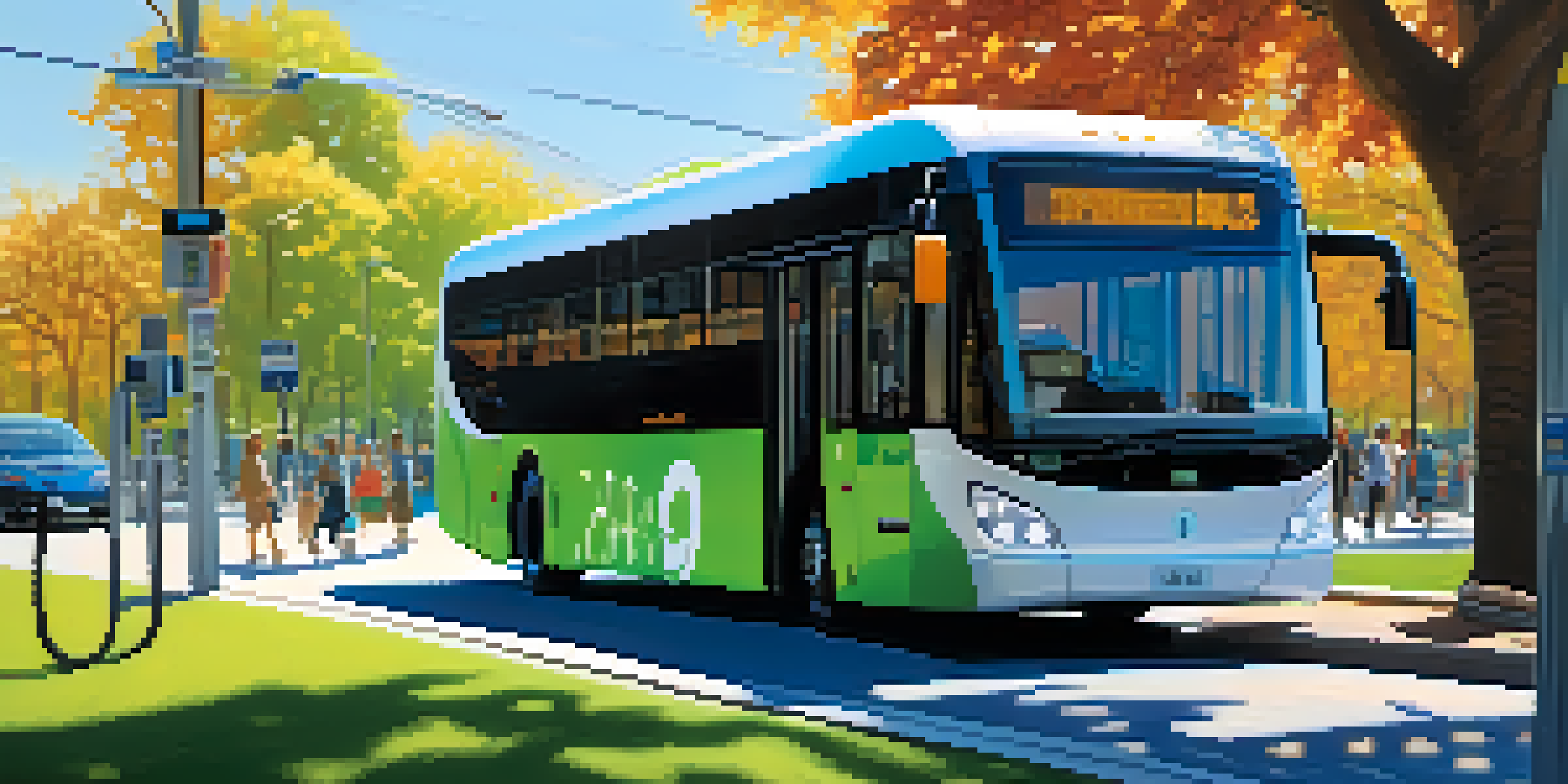Exploring Electric Buses: A Green Revolution in Transit

What Are Electric Buses and How Do They Work?
Electric buses are vehicles powered by electric motors instead of traditional internal combustion engines. They run on electricity stored in batteries, making them a cleaner alternative to diesel or gasoline-powered buses. These buses recharge at depot stations or through on-route charging systems, ensuring they can operate efficiently throughout the day.
The electric bus is an important part of the future of public transportation, leading us toward a cleaner and more sustainable urban environment.
The technology behind electric buses includes regenerative braking, which captures energy usually lost during braking and uses it to recharge the batteries. This not only enhances the bus's efficiency but also extends its range. By harnessing this innovative tech, electric buses can cover substantial distances, making them practical for urban transit.
As cities strive for sustainability, electric buses represent a significant shift in public transport. They help reduce greenhouse gas emissions, improve air quality, and contribute to quieter urban environments. In essence, they are not just a new mode of transport; they are a step towards a greener future.
The Environmental Benefits of Electric Buses
One of the most compelling reasons to adopt electric buses is their environmental advantage. By eliminating tailpipe emissions, they help decrease air pollution in cities, leading to healthier communities. Studies have shown that electric buses can significantly reduce harmful pollutants like nitrogen oxides and particulate matter, which are detrimental to public health.

Additionally, electric buses contribute to lower carbon emissions, especially when charged with renewable energy sources like wind or solar power. This makes them a crucial player in the fight against climate change. For instance, a fleet of electric buses can save tons of CO2 emissions annually, showcasing their potential for positive environmental impact.
Electric Buses Boost Urban Sustainability
Electric buses significantly reduce greenhouse gas emissions and air pollution, contributing to healthier communities.
Moreover, the shift to electric buses aligns with global sustainability goals, encouraging cities to invest in cleaner technologies. As public awareness of climate issues grows, communities are increasingly supporting initiatives like electric bus programs. This collective push for greener transit options highlights the importance of environmental consciousness in modern urban planning.
Economic Advantages of Implementing Electric Buses
Electric buses can bring significant economic benefits to cities and transit authorities. While the initial investment may be higher than traditional buses, the long-term savings on fuel and maintenance costs can be substantial. Electric motors are generally less complex and require less maintenance than diesel engines, leading to lower operational costs over time.
Electric buses are not just a trend; they represent a significant commitment to reducing emissions and improving the quality of life in our cities.
Additionally, electric buses can help reduce the overall expenses associated with public health. By improving air quality and reducing pollution-related health issues, cities can save on healthcare costs. Furthermore, cleaner air can lead to increased productivity and improved quality of life for residents, creating a healthier and more vibrant community.
Moreover, the growing electric vehicle market presents job opportunities in manufacturing, maintenance, and charging infrastructure development. As cities transition to electric bus fleets, they can stimulate local economies and foster innovation. This economic boost adds another layer of incentive for municipalities to embrace electric buses as a viable transit solution.
Challenges Facing the Adoption of Electric Buses
Despite their advantages, the transition to electric buses is not without challenges. A significant concern is the availability and cost of charging infrastructure. Cities need to invest in robust charging stations to support a fleet of electric buses, which can require substantial upfront capital and planning.
Another challenge is the range of electric buses. While advancements in battery technology have improved their operational range, some routes may still exceed the capabilities of current models. Transit authorities must carefully assess their routes and ensure that electric buses can reliably meet service demands without running out of power.
Economic Benefits of Electric Buses
While initial costs are higher, electric buses offer long-term savings on fuel and maintenance, benefiting local economies.
Finally, there are also concerns about battery disposal and recycling. As electric buses gain popularity, the environmental impact of battery production and disposal becomes increasingly relevant. Developing sustainable practices for battery lifecycle management will be crucial as we move towards a more electric future in public transit.
Real-World Examples of Electric Bus Implementation
Cities around the globe are already reaping the benefits of electric buses. For instance, Los Angeles has committed to transitioning its entire fleet to electric by 2030, setting a significant example for urban transit. Their efforts not only aim to reduce emissions but also to promote public health and sustainability.
Similarly, Shenzhen, China, has made headlines by converting its entire fleet of over 16,000 buses to electric. This monumental shift has drastically improved air quality in the city and showcases the potential scale of electric bus implementation. The city’s success has inspired others to explore similar initiatives, highlighting the global movement toward greener transportation.
In Europe, cities like London and Amsterdam are also investing in electric buses, integrating them into their existing public transit systems. These examples illustrate that with commitment and planning, electric buses can become a standard aspect of urban transit, paving the way for a more sustainable future.
The Future of Electric Buses: What Lies Ahead?
The future of electric buses looks promising, with ongoing advancements in battery technology and infrastructure development. Innovations like faster charging options and longer-lasting batteries are on the horizon, making electric buses even more viable for public transit. As technology evolves, we can expect to see electric buses with greater range and efficiency, further enhancing their appeal.
Moreover, as communities push for sustainability, governments are likely to implement incentives for adopting electric buses. These could include grants, tax breaks, or subsidies to help offset initial costs. Such measures can accelerate the transition, making electric buses a common sight on the streets.
Community Engagement is Essential
Involving communities in the electric bus movement fosters support and awareness, ensuring the successful adoption of cleaner transit options.
Lastly, public interest and advocacy for greener transportation options are growing. As citizens push for change, transit authorities will be compelled to listen and adapt. With the combined efforts of technology, policy, and public support, the electric bus revolution is set to reshape urban transit for generations to come.
Engaging Communities in the Electric Bus Movement
Engaging the community is a crucial aspect of implementing electric buses successfully. Public awareness campaigns can educate residents about the benefits of electric buses, fostering greater acceptance and support. When communities understand the positive impacts on air quality and health, they are more likely to advocate for electric transit options.
Additionally, involving local stakeholders such as businesses, schools, and environmental groups can create a broader coalition for change. By collaborating on initiatives and sharing resources, these groups can amplify their voices and push for electric bus adoption. This grassroots approach ensures that the community's needs and concerns are addressed throughout the transition process.

Finally, providing opportunities for residents to experience electric buses firsthand can enhance community engagement. Organizing ride-along events or informational sessions can help demystify the technology and showcase its benefits. By fostering a sense of ownership and pride in the electric bus movement, communities can play an active role in shaping their transit future.